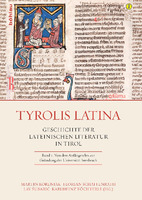Tyrolis Latina
Geschichte der lateinischen Literatur in TirolBand I: Von den Anfängen bis zur Gründung der Universität InnsbruckBand II: Von der Gründung der Universität Innsbruck bis heute
Author(s)
Korenjak, Martin
Schaffenrath, Florian
Subaric, Lav
Töchterle, Karlheinz
Language
GermanAbstract
In the territory of historical Tyrol (i.e., the present Austrian province of Tyrol, South Tyrol, and Trentino), a huge number of Latin texts has been written from the Early Middle Ages to the 21th century. A good part of this literature has been preserved as manuscripts or printed books in the libraries and archives of monasteries, schools, universities, cities and other institutions. The present history of literature for the first time gives a systematic overview of these writings and describes them according to historical eras and literary genres. The single eras are separated from each other by events that had a massive impact on the conditions of production and reception of Latin literature in Tyrol. Each era is first generally characterised in historical and cultural terms; after that, its Latin poetry, rhetoric and eloquence, historiography, biography, epistolography, theology and other ecclesiastic writings, philosophy, medicine, natural sciences, law and jurisprudence are treated in single chapters.
The literary history consists of two volumes. The first one includes the eras „From the beginnings to the unification of Tyrol under Count Meinhard II. (1285)“, „From the unification of Tyrol to the death of Emperor Maximilian I. (1519)“, „The 16th century until the death of Ferdinand II., Archduke of Further Austria (1595)“, and „The 17th century until the extinction of the Tyrolian line of the Habsburgs (1665) and the foundation of the University of Innsbruck (1669)“.
The second volume comprises the eras „From the foundation of the University of Innsbruck to the abolition of the Jesuit order (1773)“, „From the expulsion of the Jesuits to the revolution of the year 1848“, and „From the revolution of 1848 until the present day“ as well as the bibliography and the indexes. Von der umfangreichen Produktion lateinischer Texte, die auf dem Gebiet des historischen Tirol (heutiges Bundesland Tirol, Südtirol und Trentino) seit dem frühen Mittelalter bis ins 21. Jahrhundert entstanden sind, hat sich in den Bibliotheken und Archiven von Klöstern, Schulen, Universitäten, Städten und anderer Institutionen eine beträchtliche Zahl an Handschriften und Drucken erhalten. In der vorliegenden Literaturgeschichte werden diese Texte erstmalig systematisch gesichtet und nach Epochen und Gattungen gegliedert dargestellt. Als Epochengrenzen dienen Einschnitte und Ereignisse, die sich markant auf die Produktionbedingungen und Rezeption lateinischer Literatur in Tirol ausgewirkt haben. Jede Epoche wird zunächst allgemein in ihren historischen und kulturellen Entwicklungen charakterisiert, ehe sich Spezialbeiträge mit lateinischer Dichtung, Rhetorik und Beredsamkeit, Geschichtsschreibung, Biographie, Epistolographie, Theologie und kirchlichem Schrifttum, Philosophie, Medizin, Naturwissenschaft, Recht und Rechtswissenschaft befassen.
Der erste der beiden Bände dieser Literaturgeschichte umfasst die Epochen "Von den Anfängen bis zur Tiroler Landeseinheit unter Graf Meinhard II. (1285)", "Von der Tiroler Landeseinheit bis zum Tod Kaiser Maximilians I. (1519)", "Das 16. Jh. bis zum Tod Erzherzog Ferdinands II. von Tirol (1595)" und "Das 17. Jh. bis zum Aussterben der Tiroler Linie der Habsburger (1665) und der Gründung der Universität Innsbruck (1669)".
Der zweite Band dieser Literaturgeschichte umfasst die Epochen, aus denen sich das meiste Textmaterial erhalten hat: „Von der Gründung der Universität Innsbruck bis zur Aufhebung des Jesuitenordens (1773)“, „Von der Vertreibung der Jesuiten bis zur Revolution 1848“ und „Von der Revolution 1848 bis heute“. Außerdem schließen sich Bibliographie und Indices an.
Keywords
Neo-Latin; Tyrol; History; LiteratureDOI
10.26530/oapen_574820ISBN
9783205788683OCN
1030820403Publication date and place
2012Imprint
BöhlauClassification
History


 Download
Download